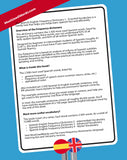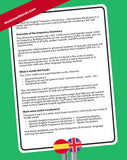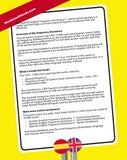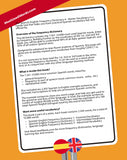Why Choose Our Frequency Dictionaries?
Key Benefits:
-
Learn Fast: Focus only on the words you actually need.
-
Expand Naturally: Discover Spanish grammar and idioms through real-world example sentences.
-
Always Pronounce Correctly: Thanks to the International Phonetic Alphabet (IPA).
-
Read Anywhere: Instantly downloadable PDF format. Works on all devices (iOS, Android, e-Readers, PCs, Macs).
-
Risk-Free Purchase: 30-day 100% money-back guarantee. No questions asked.
Key Features:
-
Covers 98% of spoken Spanish and 97% of written Spanish.
-
10,000 Spanish-English example sentences (roughly 400,000 words — equivalent to reading 4 bilingual novels!).
-
Words are sorted by frequency, alphabet, and part of speech for optimal learning.
Unlock Spanish Fluency Fast
Not all words are created equal.
Why waste time learning rare vocabulary you’ll barely use? Our Spanish-English Frequency Dictionaries Set focus on the 10000 most important and most commonly used words — so you learn smarter, faster, and more efficiently.
Here’s the reality:
In every language, a small fraction of words makes up the vast majority of everyday conversations. This is known as Pareto’s Principle — the famous 80/20 rule — but in language learning, it’s even more powerful:
-
Just 5% of Spanish words cover 95% of everyday conversations.
-
Knowing the right 10.000 words gives you nearly full fluency!
For example:
The Collins Spanish Dictionary lists 310,000+ words...
But you only need 1.62% of them — just 5000 words — to express yourself fluently and understand 95% of spoken and written Spanish.
Bottom line: Focus on the words that matter most, and you'll turbocharge your learning journey.
How Many Words Do You Need to Speak Spanish?
Research shows approximate vocabulary targets for different levels of fluency:
-
250 words: Build basic sentences (essential survival vocabulary).
-
750 words: Everyday conversations become possible.
-
2500 words: Say nearly anything you need, with some creativity.
-
5000 words: Speak fluently like a native without higher education.
-
10,000 words: Reach full, educated fluency and understand nearly everything you hear or read.
Why Learn Spanish?
Connect Across Cultures
Speaking another language unlocks deep, meaningful human connections at home and abroad.
Boost Your Career
Language skills give you a powerful edge in today’s global economy.
Feed Your Brain
Bilinguals show better memory, sharper critical thinking, multitasking, and listening skills.
Travel Like a Local
Go beyond tourist basics and experience Spain, Latin America, and the world authentically.
Supercharge Your Confidence
Learning Spanish pushes you outside your comfort zone — and rewards you with real, lasting achievement.
Start Speaking Spanish Instantly!
✅ Learn the 10,000 Most Useful Words — Organized Smartly by Frequency and Alphabet
✅ Master Pronunciation with Easy Phonetic Guides
✅ Absorb Grammar and Vocabulary Naturally Through Context
✅ Expand Your Reading and Listening Skills — Fast!









